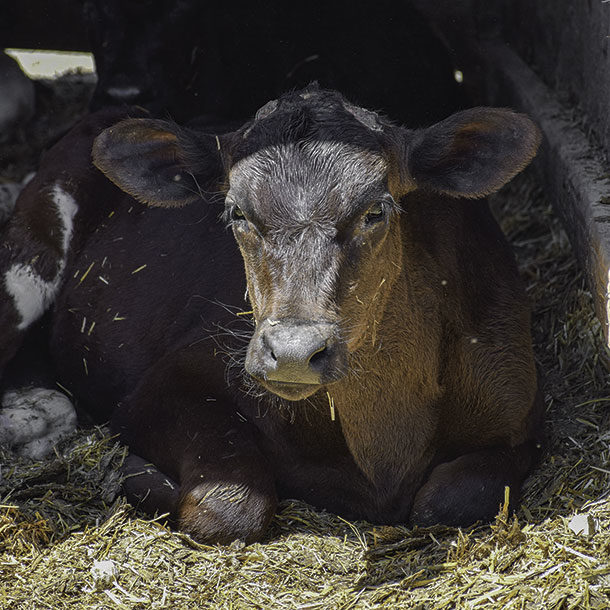Many U.S. dairies have adopted the use of semen from beef sires as part of an overall shift in their A.I. program. This practice increased significantly during 2018, with more calves than ever entering the cattle feeding pipeline in late 2019 and throughout 2020.
There are many unknowns inherent in this new system, from bull genetics to carcass value. Cattle feeders should approach this opportunity by giving up-front attention to sourcing calves and marketing fed cattle. Feeding and management are a secondary focus, given that they are aspects of the process clearly within the feeder’s control. The priorities and perspectives of both dairy producers and packers will influence the profit potential and success of cattle feeders within the crossbred dairy-beef value chain.
The dairy perspective
The increase in availability and use of dairy sexed semen has made it easier for dairies to produce heifers and meet their needs for cull cow replacement. However, the conception rate with sexed semen is lower than with conventional semen, and while the target number of heifer calves can be attained, more A.I. services are often required to achieve conception. Cows unable to conceive after several services are not good candidates for providing the next generation of replacement heifers.
Every cycle counts when it comes to both semen expense and lost milk production. After two to three attempts using higher-priced sexed semen and failing to conceive, the use of conventional semen from beef sires is a lower-cost option. The goal is no longer to produce a replacement heifer but simply to increase the likelihood of conception and to get the cow back into lactation sooner. The resulting crossbred dairy-beef calf, whether bull or heifer, is destined for beef production, just as a Holstein bull calf would be.
In addition to improved conception rates and a lower cost per service, dairies can also realize other benefits when using conventional beef semen. Selecting low birthweight sires for calving ease appeals to heifer breeders and reduces stress, dystocia and recovery time for calving cows. Since the beef industry has historically valued sires with low birthweight expected progeny differences (EPDs), semen is readily available to target this goal.
When considering calf value, straight-bred dairy steers – whether Holstein or Jersey – are discounted relative to beef cattle at all points along the value chain. Dairies may also seek to obtain a premium for day-old crossbred calves, given the perception that they will exhibit stronger beef performance and carcass traits than their straight-bred dairy counterparts. However, this premium may not exist, or crossbreds could even be discounted relative to Holstein calves.
From the dairy perspective, incorporating beef semen into the A.I. program is a logical step in the attempt to meet several objectives. However, the benefits associated with conception and calving don’t necessarily align with the priorities and requirements of the cattle feeder and packer. The cattle feeding and packing market segments are more interested in potential breed complementarity and in using beef genetics to compensate for shortcomings in dairy-based carcasses and performance.
The packer: Bids with an eye on the retail market
A good supply of beef cattle has put packers in the driver’s seat, allowing for more leverage and selectivity on what they will pay – as well as accept – when buying fed cattle. Before making a bid, they consider where the primary cuts will fit in the retail and restaurant markets. Cattle buyers are tasked with providing relatively consistent carcasses of predictable quality and size of cuts to meet their customers’ needs. This system has a low tolerance for the unknown.
Packers know what to expect when buying finished Holstein steers, high-marbling Angus yearlings and even cull cows. They recognize what the cattle are worth and understand where they will fit in the retail market. Enter the dairy-beef crossbreds – an unknown commodity. The points of reference used to establish bids become unclear when considering how the dairy influence will interact with unknown genetics originating from numerous different beef breeds.
What traits will be realized? Did bull selection include any consideration of carcass merit? How many different beef breeds were represented in the A.I. program, calf facility and feedlot? Each step in the process can introduce more variation in the end product and uncertainty for the cattle buyer. Given the level of risk for packers and the inconsistency associated with the dairy-beef crossbred animal, some packers have elected to turn away from this option entirely – or at best, pay Holstein steer price. For the cattle feeder, recapturing the premium paid above Holstein calf price can prove elusive when marketing finished cattle.
The cattle feeder: Know your source and your destination
For a traditional Holstein feeding program, cattle feeders know what to expect and what to be cautious about. Genetics and ration programs are predictable, yielding an acceptable range for gain, conversion, carcass weight and marbling. On the other hand, calf health is a wild card that is often out of the cattle feeder’s control; it is predetermined by the dairy’s attention to providing timely colostrum to the newborn calf.
An inconsistent immune status also exists in crossbred dairy-beef cattle but, unlike the more consistent Holstein program, this is also coupled with the uncertainty of expected performance, weight at finish and ability to muscle and marble. Simply purchasing crossbred dairy-beef animals and assuming their performance and health will resemble that of a beef steer more than a Holstein is a roll of the dice.
For cattle feeders, knowing the source of the calves going back to the dairies can alleviate some of the risk associated with health and breed variation. While there are A.I. programs that involve random pairings with conception and calving ease as the only goals, there are also some very good programs established that target calf growth and carcass characteristics.
Semen companies and beef breed associations continue to develop protocols to match beef sires to the dairy genetic base and deliver a better-feeding, better-finishing animal with a more desirable carcass. The genetic base for both cows and bulls will determine how crossbred dairy-beef calves will perform and finish, as well as the value of wholesale cuts. In addition to the dairy/beef breed diversity, consider the potential influence of English versus Continental beef sire breeds. Some cattle feeders have resorted to providing straws to the dairies to attain a measure of predictability and consistency to the feeders they will purchase.
As previously mentioned, the packer, or more precisely the retailer, has the last word on the value of fed cattle. Cattle feeders should not assume beef-influenced dairy calves will garner a premium above the Holstein base price at marketing time. Part of a successful crossbred dairy-beef feeding program is to establish where the cattle can be shipped and what to expect for bids.
Since some packers have shied away from purchasing crossbred dairy-beef cattle entirely, the only option left to the cattle feeder is those few packers willing to enter this market as price-makers. Just as important as knowing the source and background of the calves is knowing in advance where they will go.
Dairies entering the crossbred feeder calf market have added a new layer of variation to the beef feeding complex beyond that associated with mixed lots of put-together sale barn ranch calves. However, for cattle feeders, the rules have not changed; know what you’re getting, feed them and develop a marketing plan in advance.
We can expect to see more crossbred dairy-beef calves available – and just like any new offering, there will be a lag time as their value gets established for every step of the value chain. The market will respond to the balance between supply and demand and dictate net returns allocated to dairies, feeders and packers. Until this point is reached and the market settles on what these calves and carcasses are worth, cattle feeders should do what they can to reduce variation in what they purchase to improve their position on sale day. They can expect that buying the unknown will result in an uncertain outcome.








